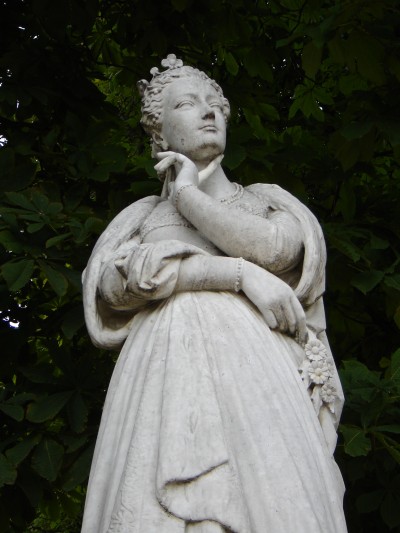
Statue in Jardine du Luxembourg

August 2, 2008
Yay! Alex, Chris and I put our paper about
categorified
symplectic geometry on the arXiv! I hope this will be
the beginning of a larger exploration of the interface between
categorification and classical mechanics.
Chris Rogers may
work more on this.
Ken Caldeira thinks the most practical way to fight global warming is putting lots of sulfur dioxide into the upper atmosphere:
To me, it's like spinning plates: I'm not sure how long we can keep this trick going.An example: one-third of the more than 700 species of reef-building corals are threatened with extinction. A decade ago only 2% of corals species were endangered... but over the last 50 years, we've lost about a quarter of all reefs, and we can expect more to go.
Ah! A love nest!
This became a running joke between Lisa and me for the rest of our stay.
August 4, 2008
Now the truth can be revealed: together with my graduate students
Alex Hoffnung, John Huerta, Chris Rogers and Christopher Walker,
I applied for an received a grant from the Foundational Questions Institute, for a project
on categorifying fundamental physics.
This will allow these students to spend more time doing research for the
next two years.
August 6, 2008
Paul-André and I have been meeting regularly at
Café
Rostand across from the Luxembourg Garden. He brings with
him a Mac and an enormous artist's sketchpad on which he draws
string
diagrams. We're trying to understand computation and logic
using higher categories, a project I've been working on with Mike
Stay ever since the fall of 2006. To do this I want to understand such
things as "the free cartesian closed 2-category on a lambda-theory",
in which 2-morphisms are processes of computation. Paul-André
instantly brought a higher level of sophistication to the
project, since he's been working for quite a while on
rewrite
rules and game semantics in proof theory. So,
we're now engaged in some fascinating explorations.
Today I took a break and wrote up some of what I've learned
in "week268"
of This Week's Finds. I'm particularly fascinated by the mysterious
relation between propositional logic and 2d topological quantum
field theories!
August 8, 2008
This evening we went to the Louvre with Paul-André and
his daughter; they're open late on Fridays. We saw a lot of
Greek, Etruscan and Egyptian art. It made me want to learn
more history! I was especially struck by the sophistication of
some Etruscan stautes dating back to the 8th century BC. They
have a liveliness and informality that seemed so different from
the formality of most, say, Egyptian or Babylonian art of the time.
What were the Etruscans like?
But then I saw a cute little Egyptian statue of a cat playing with
a kitten... so, clearly not all their art was the monumental
serious religious stuff we're used to seeing.
August 11, 2008
We'd only been able to lease our studio apartment until the 11th, so
today we moved to an even smaller place around the corner:
a room at the Hotel des Trois Colleges on Rue Cujas.
It's sort of sad moving to ever smaller places — it's
like we're gradually leaving Paris, a bit at a time — but it
has the advantage of making me eager to return home.
We've been walking around more on the right bank.

August 15, 2008
Back home in smoggy Southern California. Our garden is fine except
for a dead jasmine plant and some ground cover and tomato plants
that had mysteriously vanished — our gardener must have
gotten rid of them. The century plant is doing great.
It's time to get a lot of work done!
August 19, 2008
If you're one of
the people who is saddened by the decline of popular science magazines
Scientific American and The New Scientist, I
strongly urge you to subscribe to American Scientist.
It's great! There's a wonderful article in the latest issue:
David Wilson has recently been pushing for a more nuanced view called multilevel selection. Groups of different sizes — cells made of organelles, organisms made of cells, families made of organisms, herds or tribes made of families, species made of herds or tribes — can succeed and propagate as groups thanks in part to altruistic behavior of their constituents. As the Wilsons (themselves a family group!) put it:
These interacting layers of competition and evolution are like Russian matryoshka dolls nested one within another. At each level in the hierarchy, natural selection favors a different set of adaptations. Selectrion between individuals within groups favors cheating behaviors, even at the expense of the group as a whole. Selection between groups within the total population favors behaviors that increase the relative fitness of the whole group — although these behaviors, too, can have negative effects at a still-larger scale. We can extend the hierarchy downward to study selection between genes within a single organism, or upward to study selection betwen even higher-level organisms.They present some fascinating evidence involving slime molds, termite colonies, biofilms formed by the bacterium Pseudomonas fluorescens, and so on. And, there are some downright scary experiments:
William Muir of Purdue University compared two kinds of selection for egg productivity in hens. The hens were kept in cages, with several hens per cage. In the first experiment, the most productive hen within each cage was selected to breed the next generation (within-group selection). In the second experiment, all hens within the most productive cages were used to breed the next generation (between-group selection). In the first experiment, the most productive hen in each cage achieved her productivity largely by bullying the other hens. After six generations, a hyper-aggressive strain had been produced, with hens plucking each other's feathers in incessant attacks that were sometimes fatal. Egg productivity plummeted over the course of the experiment, even though the most productive hens had been chosen in every generation. In the second experiment, group-level selection resulted in a docile strain of hens, and egg productivity increased 160 percent in six generations.(Why does the first experiment remind me of conservative talk radio shows in the US?)
I'm sure the arguments about the
unit of
selection are just starting; it's a very slippery subject.
Someday I hope mathematicians will get interested in "games
with ill-defined players": players that can themselves be loosely
defined alliances of other players.
August 20, 2008
The Bush administration continues its criminal habits: now
it seems that up to 225 days of White House email have been
"lost". These emails have been sought for
months, since they're important in a number of
investigations. But, we won't be seeing them anytime soon:
Washington (AP) - The White House is missing as many as 225 days of e-mail dating back to 2003, according to an internal draft document obtained by The Associated Press.Also check out the Sierra Club's list of eco-heroes: civil servants trying to do their jobs and protect the environment, who were either forced to quite, or were fired by Bush and his cronies. A typical case:The nine-page document invites companies to bid on a project to recover the missing messages. It outlines a process in which contractors would try to retrieve lost e-mail from 35,000 disaster recovery backup tapes dating back to October 2003. The period covers such events as growing violence in Iraq, the Abu Ghraib prison scandal and the probe into the disclosure of a CIA operative's identity.
The project would apparently not include backup tapes going back to March 2003, even though an earlier White House assessment suggested e-mails were also missing from that period.
The work would be carried out through April 19th, 2009, according to the request by the Office of Administration for contractors' proposals, which was dated June 20th.
Last week, the White House declined to comment on the document.
Earlier today, the White House said only that the information is "outdated and seriously inaccurate."

WHAT WENT WRONG: Asked by his superiors to assess a proposal to divert water from the Klamath River to downstream farmers, Mike Kelly argued that threats to endangered coho and chinook salmon and other protected species made the plan illegal. He was overruled by the "God Squad," a committee appointed by Vice President Dick Cheney to allow emergency exemptions to the Endangered Species Act. The irrigation plan went forward, resulting, in 2002, in a river choked with 70,000 dead salmon.THE HEAVY: Former Interior secretary Gale Norton and Cheney's "unseen hand."
THE PRICE: Faced with political interference, Kelly resigned in 2004 and now works as a private environmental consultant.
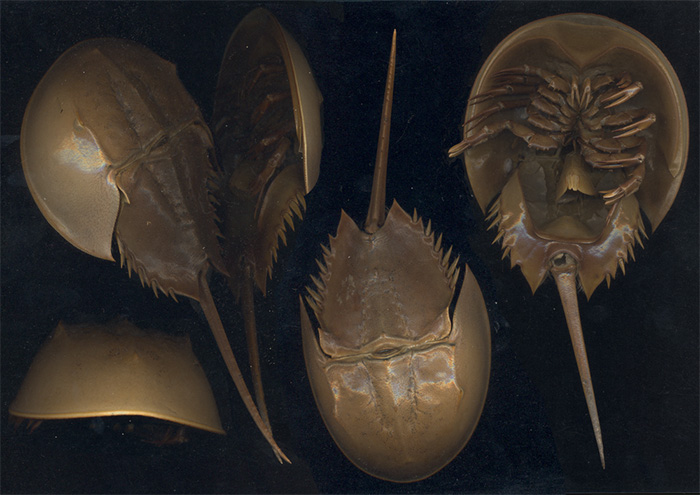
On a happier note: people are working to save the horseshoe crab on the Atlantic coast of the US, and it may be working!
There are lots of threats to horseshoe crabs. Fisherman chop them up and use them as bait — in fact they're sold for this purpose, for just $1 each. And every year, about 10% of horseshoe crabs die when surf flips them on their back and they can't succeed in righting themselves.
So: Just flip 'em! Not by the tail, though.
Another cool thing about horseshoe crabs is that their blood uses
hemocyanin
instead of hemoglobin.
So: copper instead of iron! I'm not sure if that's true of
all arthropods, or just some. Like all arthropods,
they also have an open circulatory system: there's no distinction
between blood and the interstitial fluid between cells.
August 21, 2008
The Weaire-Phelan structure is in the news:
Another interesting article:
A rational approach to food takes into consideration the water used from planting to production to harvest to animal husbandry to distribution to the table and to the garbage. In western countries, this process is remarkably inefficient for a variety of reasons. First, and perhaps foremost, the average U.S. citizen "consumes" 3,900 kilocalories per day, far more than the 1,500 to 2,900 kilocalories per day needed for good health. Of this, some 35 to 45 percent goes to waste — enough to supply 80 percent of the typical Bangladeshi's diet. Altogether, this amounts to about 5,000 liters of virtual water per day per person, distributed between water to grow plants that are in turn fed to animals, which are then fed to human beings, who deposit at least a third in the garbage. The author argues that simply by practicing sensible carnivory (reducing meat eating by 30 percent), U.S. and European Union residents could eliminate the need for about 250 cubic kilometers of virtual water per year.Virtual water is perfectly real: it's just a name for the total amount of water used to accomplish something. It's a term invented in the 1990s by John Anthony Allan of the School of Oriental and African Studies at the University of London.
On another front, Infinera and Luxtera are coming out with integrated optical circuits — that is, roughly, chips based on photonics instead of electronics. So far these chips have at most 100 optical circuits each. But wait and see...
There's a new album by two of my favorite musicians: David Byrne and Brian Eno. It's called Everything That Happens Will Happen Today. And, it's free online!
In fact you can listen to it right here:
The world is so cool...
Some reviewers think the song "I Feel My Stuff" is too weird.
I think it's great. It's got that chilly piano that Eno used
on "Iced World" — but now mixed with a funky back beat
and utterly insane lyrics sung with complete conviction by Byrne.
Then comes the Brazilian samba-esque chorus of Eno singing
"deh, deh-deh, deh-deh deh". Then an aggressive horn section
joins in... and then we get a blistering guitar solo. What more
could you want from a song? ![]()
But, this song is actually very different from most on the album. Most of them have suspiciously simple, folky, uplifting harmonies — they call it "electronic gospel". The album is utterly, totally different from their last one, the world-shattering My Life in the Bush of Ghosts, so if you're looking for some sort of repeat of that, forget it.
If you can't stand listening to this new album, you may still have fun reading about it:
The LA Times used to be a great paper. It was a key part of our morning routine: I'd get up, make coffee and bring in the paper, and Lisa and I would read it while talking and listening to the NPR's morning news show.
But in 2000, the LA Times was bought by the same company that owns the Chicago Tribune, and they began rounds of cutbacks and layoffs in a misguided attempt to combat the effects of gradually declining subscriptions. John Carroll, former editor of the Baltimore Sun, was brought in to edit the paper. During his reign he eliminated more than 200 jobs — but that wasn't enough for the Tribune Company. The LA Times was making a profit — but not enough to make the Tribune Company happy. The LA Times was only making 20% profits, while the Chicago Tribune was making 30% profits.
John Carroll resigned in 2005 after refusing to make still more cutbacks, and he was replaced as editor by Dean Baquet. The LA Times was still great during this era: its investigative journalism won more Pulitzer prizes than any other paper than the New York Times. There were often more interesting articles than I had time to read.
But in November 2006, Baquet was himself ousted for not meeting the demands of the Tribune Group. He was replaced by James O'Shea.
Sometimes when you take a job, you deserve what you get. On January 20th of this year, James O'Shea was fired by publisher David Hiller after refusing to make $4 million more in cuts.
And then, on July 14th, while I was in Europe obliviously enjoying myself with my subscription to the Times on hold, David Hiller himself resigned. The editor of the Chicago Tribune, Ann Marie Lipinski, resigned on the same day. Why? Perhaps because the Times was slated for further cuts: 250 more positions gone, including 150 in the newsroom.
Now, for a long time, the book review section is the first thing Lisa reaches for on Sunday mornings — simultaneously with a cup of coffee. She continued doing this even as this section gradually shrank to a pale shadow of its former self. Earlier this year, it was ignominiously merged with the "opinion" section — a collection of editorials and political cartoons that once was a proud section of its own. The two were stuck back-to-back, each one upside-down with respect to the other, so you had to flip the darn thing midway while reading it. Still, that is what she read first.
I began to feel sorry for Lisa. There's a special kind of pity you feel for someone who respects a once noble institution after it's gone bad and ceases to return that respect. I suggested quitting our subscription, but Lisa convinced me that newspapers should still be supported. You can get your news off the internet, she said, but there still need to be reporters somewhere to get this news. I agreed: the Los Angeles Times was going through bad times, but it had good journalists, so there was always a chance that it could recover. We decided to wait and see.
There were lots of rumors that some rich Los Angeles moguls would get together, buy the Times, and restore it to its former glory. But on April 2nd, the Tribune Company sold the LA Times, Chicago Tribune and other "media assets" to Sam Zell, a billionaire with no ties to Los Angeles. Intitial hopes that he'd save the paper were quickly dashed, and he became the butt of many jokes.
On July 21st, while we were away, the LA Times completely canceled the Sunday book review. Four former editors of the section wrote a joint letter complaining about this:
LOS ANGELES, Calif. — As former editors of the Los Angeles Times Book Review (1975 through 2005), we are dismayed and troubled at the decision by Sam Zell and his managers to cease publishing the paper's Sunday Book Review.When we returned from our vacation, our subscription didn't automatically restart the way it was supposed to. It took a few tries to get it restarted. So, we didn't get the paper last Sunday.This step signals the end of an era begun 33 years ago when Otis Chandler, then the paper's publisher and owner, announced the debut of the weekly section. Since then, the growth of the Los Angeles metropolitan region and the avidity of its numerous readers and writers has been palpable. For example, every year since its founding in 1996, the Los Angeles Times Festival of Books has attracted upwards of 140,000 people to the UCLA campus from all walks of life throughout Southern California. Four hundred writers from all over America typically participate. The written word is celebrated. It is the most significant civic event undertaken by the Los Angeles Times to deepen literacy and to strengthen the bond between its news coverage and its far-flung community of readers. But without the Book Review itself, the book festival will be a hollow joke.
The dismantling of the Sunday Book Review section and the migration of a few surviving reviews to the Sunday Calendar section represents a historic retreat from the large ambitions which accompanied the birth of the section.
To be sure, no section of any newspaper can remain hostage to past ways of covering the news of the day. We are convinced, however, that the way forward is to increase coverage of our literary culture — a culture that every day is more vibrant and diverse in the thriving megalopolis of Los Angeles.
Angelenos in growing number are already choosing to cancel their subscriptions to the Sunday Times. The elimination of the Book Review, a philistine blunder that insults the cultural ambition of the city and the region, will only accelerate this process and further wound the long-term fiscal health of the newspaper.
We urge readers and writers alike to join with us as we protest this sad and backward step.
Sonja Bolle
Digby Diehl
Jack Miles
Steve Wasserman
Today is Sunday. I made coffee, brought in the paper and "deveined" it as usual, removing the clotted masses of advertising supplements and throwing them in the trash. I brought it into the bedroom. Lisa looked for the book review section and didn't find it. Sometimes I throw it out by mistake. So, I retrieved everyhting from the recycling bin and helped Lisa try to find the this section. We couldn't find it! Then I looked online and discovered the sad truth: it was gone.
Goodbye, Los Angeles Times.
August 29, 2008
I had my first Skype chat with Paul-André Melliès —
me at home, him in a café.
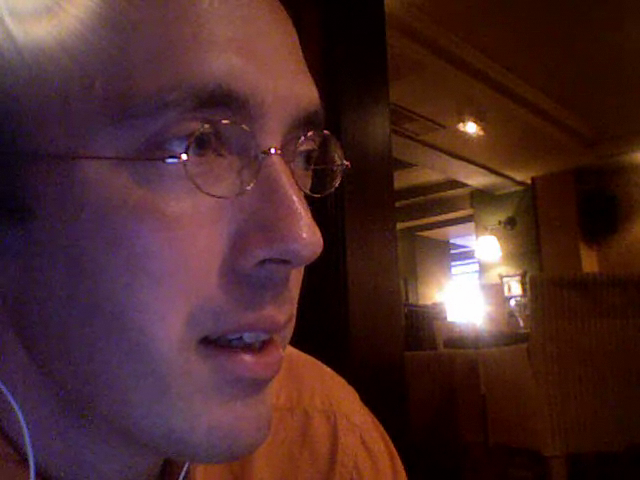

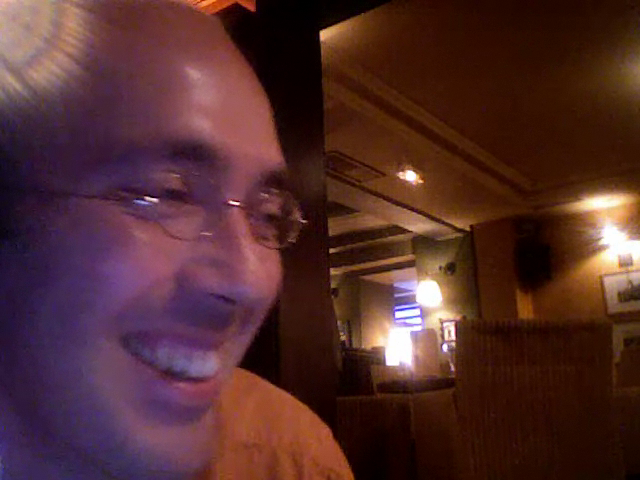
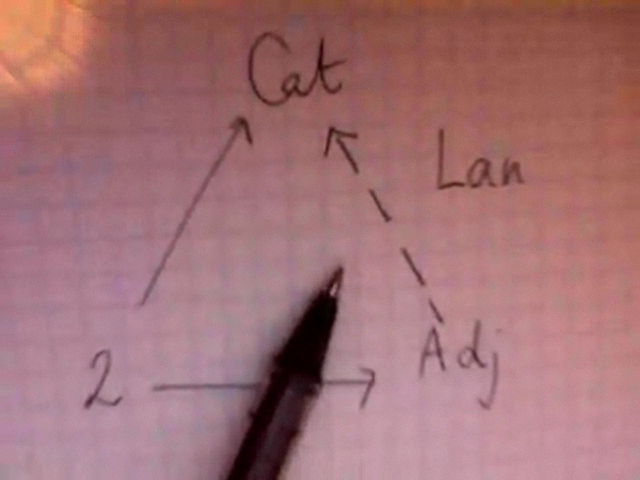
I hope this becomes a regular thing, so we can keep our collaboration
moving forwards. It's easy enough to finish up papers from afar, I've found
— but not so easy to come up with ideas in the first place.
August 30, 2008
Very soon I've got to prepare some talks for the 2008
Rankin
Lectures in Glasgow. I'm giving three talks on "My Favorite
Numbers". The first, on the number 5, is basically ready.
That one is supposed to be fun for a general audience, so it has lots of
pretty pictures. I've given it twice already, but I'm not completely
satisfied with the results — people weren't swooning in the
aisles, so I need to tweak it a little. But mainly I need to prepare talks
on the numbers 8 and 24. I leave on September 13th, so I have about
one week to prepare each talk.
I've been working hard with Aristide Baratin and Derek Wise on a paper about infinite-dimensional representations of 2-groups. It's coming together nicely.
Before switching to work on my talks, I felt the need to take a break — so yesterday I wrote an issue of This Week's Finds: "week269". I wound up spending most of my energy fitting the Weaire-Phelan structure into a bigger historical context. I only wanted to say a little about it, but history is like pulling on a loose thread: once you get started, it just keeps going!
Among other things, I ran into an interesting foreshadowing of current theories of global warming in the work of the great physicist Lord Kelvin. This is from an article in the New Castle News dated October 9, 1901:
Lord Kelvin's conclusions were stated in a lecture recently delivered before the British association for the promotion of science. He has made a study of the subject for many years. He is now past middle age, and ranks as the foremost living physicist.The following is a summary of the important points of Kelvin's theory:
'The extravagant waste of oxygen by modern manufacturing processes may leave the inhabitants of the earth without air for breathing, and that within a short and calculable time. At the present rate of progress five centuries will exhaust the full supply of the world. This means the exhaustion of oxygen.
'The sum total of oxygen at our disposal is 1,020 millions of tons. Every ton of fuel used three tons of oxygen in combustion. Consequently the burning of 340,000,000 of tons of combustibles will destroy the world's air for breathing. The population of the earth is 1,500,000,000 persons. Each has to his credit 200,000 tons of combustibles. Burn this and we die, not from lack of fuel for keeping warm, but from lack of oxygen for breath. Considering the rate at which manufacturing and commerce are depleting the coal supply, less than 500 years may see the end of the human race.'
Science has rarely offered so strange and so terrible a picture of the end of the world as Lord Kelvin's theory suggests. From various scientific authorities in New York (Hallock, Woodward, Hovey, Van Ingen, Burgess and others) interesting speculation as to the gradual approach of the final catastrophe has been gathered.
With the decrease of oxygen in the air the heat of summer would become intense. This would not be the pitiless, parching heat of the desert. Moisture would hang heavy in the air. Steam would rise from the ground and the sun would be veiled in clouds of vapor.
Lots of people think tunnels, crypts and catacombs are cool, right? It's not just me, I hope! The appeal of deep mysteries may reach its most refined form in mathematics — or maybe archaeology, or certain forms of mysticism — but surely it's not just practitioners of such esoteric arts who enjoy thinking about "buried treasure", "secret passages" and the like.
It's even better when we've got ancient underground water tunnels bringing life to the desert, right? There's the added appeal of history, and the contrast between the parched surface of the landscape and the deep tunnels full of running water. How romantic can it get?
I got interested in these irrigation systems when I read how they were being destroyed during the war in Iraq. I got more interested when I saw the canal system called an acequia at the Alhambra — see my June 25th diary entry. So, I've been poking around, trying to learn more about them.
In fact, underground irrigation systems are common throughout the Middle East, and they can be found all the way from the Gobi Desert to Spain. They have different names in different cultures: in Berber Arabic, they're called foggara; in Turkish, qanat; in Persian, qarez. You can read more about them here:
All the Iranian qanats have fish in them. These fish are healthy, normal fish, neither blind nor white; the local people do not know where they come from, but they could get into the qanats in the spring, when rivers and springs overflow their banks and whole areas become flooded. In the nineteen-fifties, Iranian peasants believed that qanat fish lived forever, needing no nourishment but their own eggs; but then they also believed that the snails which lived in the qanats were actually fish eggs. They believed that hedgehogs live on sunlight, that crocodiles flourished in the desert, and that all porcupines were immortal; they also believed that a treasure lay at the source of every qanat, and upon one day every year, the largest fish in each individual qanat wore a golden crown borrowed from this treasure hoard.
What follows is part of an article on the aflaj of Oman — perhaps the best-preserved example of an underground irrigation system. (Five of these aflaj were chosen as World Heritage sites in 2006.) I've supplemented this article with photos taken by Sue Hutton, which can be seen together with commentary on a website she runs.
Oman's "Unfailing Springs"
Lynn Teo Simarski
Saudi Aramco World, November/December 1992A pre-lslamic poet sang long ago of verdant Oman as "a goodly land, a land abounding in fields and groves, with pastures and unfailing springs." But in the region at the desert.s margin, where no natural rivers flow and where farming is impossible without irrigation, it is the splendidly-engineered aflaj, the system of underground and surface canals, that have watered the country's agriculture for millennia.
Ancient aflaj (singular: falaj) still course like arteries beneath the hills and plains of Oman, twisting along precipitous cliffs and threading villages and date-palm groves, bringing to the parched land water and coolness and life itself.
A dawoodi falaj watering a date plantation
in a village at northern edge of Wahiba Sands in Oman.
Photo by Sue Hutton.The word aflaj itself denotes not only the water canals but also the irrigation network that relies on them and the social system that apportions water to the owners of water-shares. The aflaj have helped to shape the history and settlement patterns of Oman, and they continue even now to tie together each community that draws upon the falaj's flow. As part of traditional greetings, an Omani will invariably ask about the condition of the aflaj, which evokes the reply, "Insha'allah, they are full." As concern expands over the best use of Oman's precious water resources, the state of the aflaj will undoubtedly continue to affect Omani life in the oil age and beyond.
"We have no rivers and our underground reservoirs are very limited," points out Kamal Abdurredha Sultan, a prominent Omani businessman and farm-owner concerned about the future of agriculture in Oman. "The rainfall on the whole, throughout the country, is unreliable. The past generations, perhaps realizing the circumstances, used the available water resources as efficiently as possible.... The wonderful and intricate falaj system was in complete harmony with the water circumstances and responded well to the wet and dry periods, each lasting several years, that were a feature of Oman's climate — and still are."
Different types of aflaj were built to suit the water sources available. Some 90 percent of precipitation falling on Jabal Akh-dar, northern Oman's mountainous core, percolates down to the underground water table. Those canals, known as qanat aflaj, collect water in the rock, sand, and gravel aquifers skirting the mountains' edge, and run beneath the land surface for kilometers to emerge at an oasis. The supposed length of aflaj is, in fact, grist for fables: A camel stick, dropped by the Caliph of Baghdad into the Euphrates, is said to have surfaced in an Omani well called Ain Sariq.
Cross-section of a qanat falaj. In Oman, these are also called dawoodi or iddi falaj.
About 26% of aflaj in Oman are of this type, while 47% are ghayl aflaj and 27% are ayni aflaj.
Photo by Sue Hutton.Other aflaj exploit shallow or surface waters. Most mountain wadis, or valleys, are lined with gravel and silt, which overlie consolidated rock in the valley floor. Water flows perennially through the surface layers of the wadi deposits, and this may be tapped by a ghayl falaj, which collects and conveys the water in an open channel to an oasis. Still other aflaj — ayni aflaj — simply conduct water above-ground from a spring, such as those channeling the hot springs welling up from diaphanous, calcite-encrusted pools near the towns of Nakhle and Rustaq.
The skills of falaj construction and repair are preserved today in Oman by the Awamir, a partly settled, partly nomadic tribe based near Izki, whose falaj specialists still travel throughout Oman, carrying out their trade. They have a respected reputation for water divining.
To begin a new qanat falaj, a diviner generally scrutinizes the topography, soils, and vegetation at a promising site for a mother well, or umm al-falaj, the vertical shaft down to the aquifer. Some Omani diviners are said to use less orthodox methods: A hydraulic engineer recently observed one enter a prolonged trance, during which he called upon Sulayman ibn Da'ud - Solomon, the son of David - and summoned a jinn from Africa to assist his search.
The shaft of a mother well averages 20 meters (66 feet) deep, but some mother wells descend as much as 60 meters (200 feet). At the bottom, the horizontal channel or gallery that is excavated downslope from the well is left unlined, so that the water can seep into it from surrounding porous layers.
After the collection gallery for the mother well is dug, the builders move down slope. Here they dig another vertical shaft and begin burrowing back almost horizontally toward the mother well. Crouching in the tunnel, they excavate with hammer and chisel. Successive vertical shafts extend the underground tunnel toward the point at which it surfaces kilometers away. The Awamir are particularly accomplished at excavating aflaj through hard rock - a daunting task, for a tunnel one kilometer (1100 yards) long and one-half meter (20 inches) in diameter requires removing between 3000 and 4000 tons of rock.
From the air, Oman's landscape, particularly the mountainous heartland, is dotted with holes that look like chains of bomb craters. These holes mark the successive vertical shafts sunk to excavate the horizontal tunnel of a falaj, and they indicate its course from source to the oasis. The original builders left the holes open after the underground canal was completed, so that their access shafts could be used for subsequent inspection and repair.
The hazards of falaj work are legion. In Iran, excavators baldly call the qanat falaj "the murderer" in Persian. An Oman Ministry of Agriculture engineer marvels at the skills of the original builders, who worked without air pumps or safety equipment. In an access shaft, a worker may be struck by falling stones, while tunnels pose the danger of collapse. Added to this, the stifling heat and poor air circulation within a falaj may allow work for only 20 minutes at a time. The worker faces particular danger when, tunneling uphill, he nears the mother-well gallery where water has collected. Many have drowned in the onrush of water as the final rock gives way between the tunnel and the gallery.
Oman's rugged topography tested the ingenuity of ancient planners, who produced engineering solutions that are part of Oman's architectural heritage. Some aflaj run along the contour lines, tracing the curves of wadis or valleys, like the falaj near Tanouf in the Jabal Akhdar that hugs the cliff wall high above the wadi floor. Parallel abandoned channels, cut into the wadi wall some distance above the flowing falaj, probably testify to past changes in water level or flow.
Where a falaj crossed wadis, such as near Rustaq and Nakhle on the Jabal's coastward slopes, architects bridged the valleys with arched aqueducts often more graceful than the sturdy poured-concrete ones built today. Wherever the torrential flood of a wadi was strong enough to wash away an aqueduct, engineers built inverted siphons — closed U-shaped tunnels. In these, the horizontal falaj flow disappears down a vertical shaft on one side of the wadi, tunnels straight across beneath the wadi floor, and reemerges up a second vertical shaft on the other side. Because the lip of the second shaft is slightly lower than the siphon entrance, the head of water forces the flow through the structure.
You got warheads stacked in the kitchen You treat distraction like it's a religion. - Beck, "Walls"
© 2008 John Baez
baez@math.removethis.ucr.andthis.edu